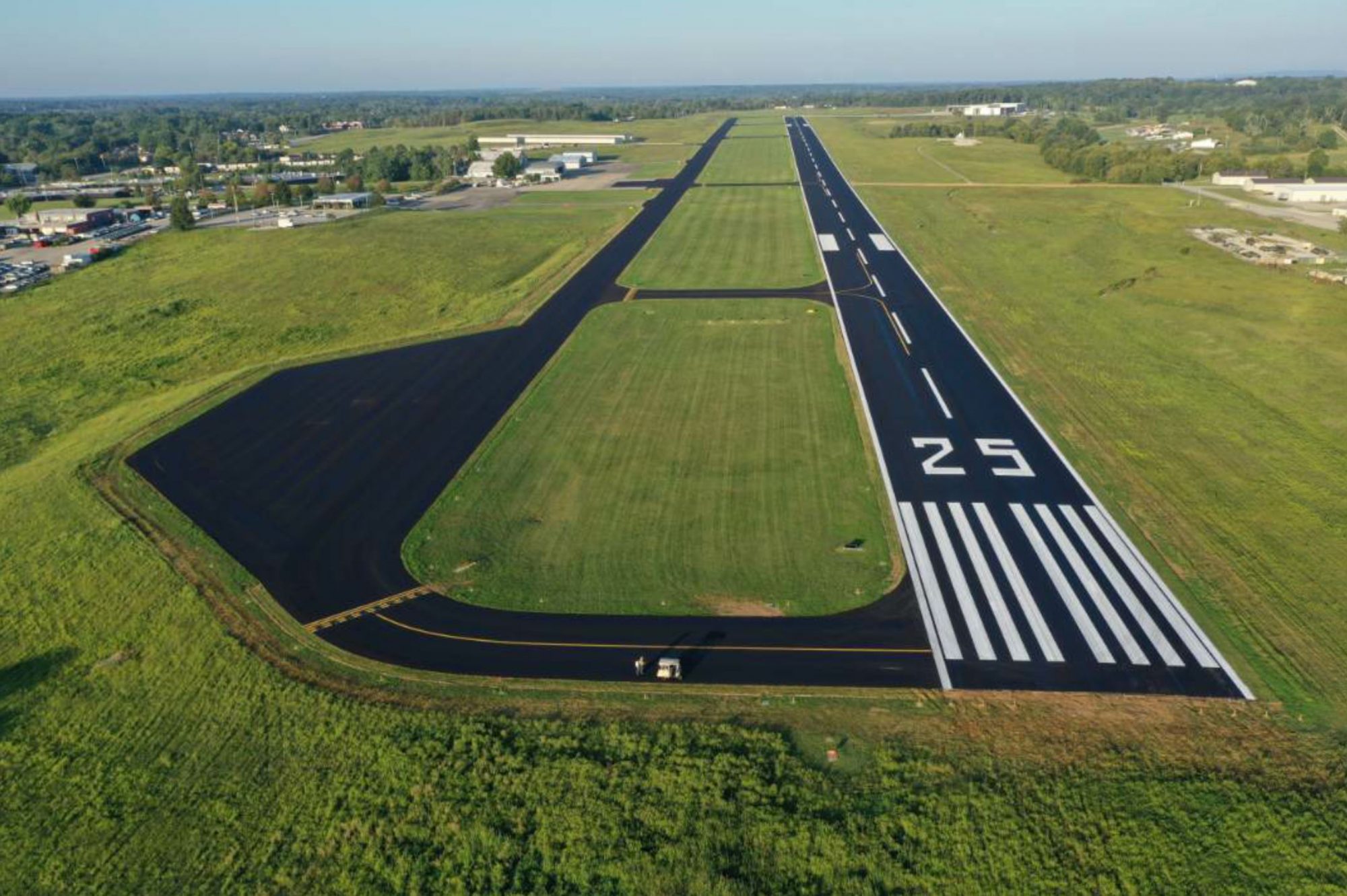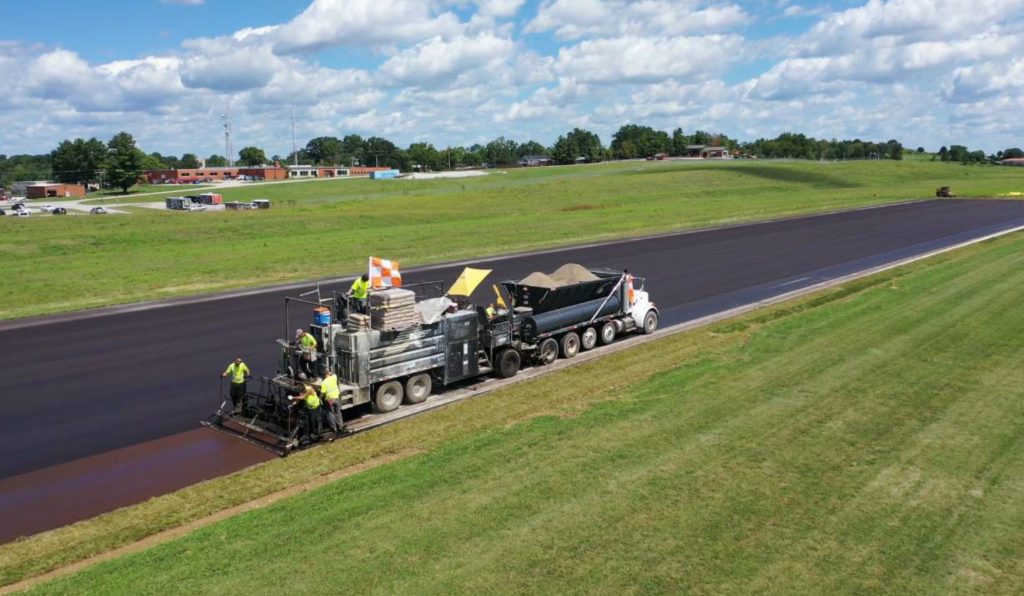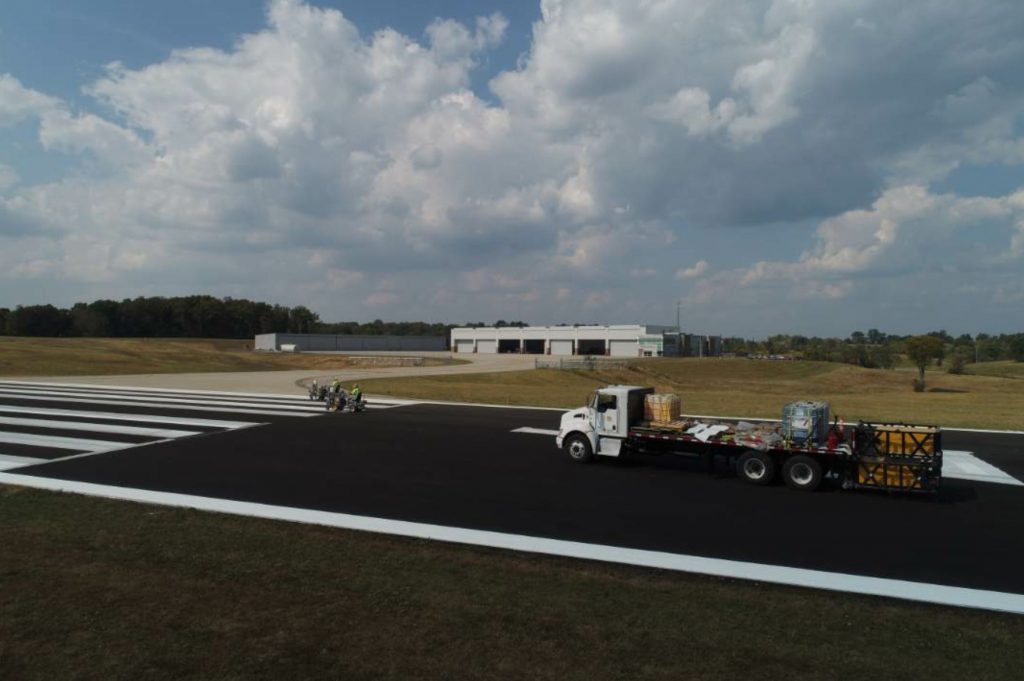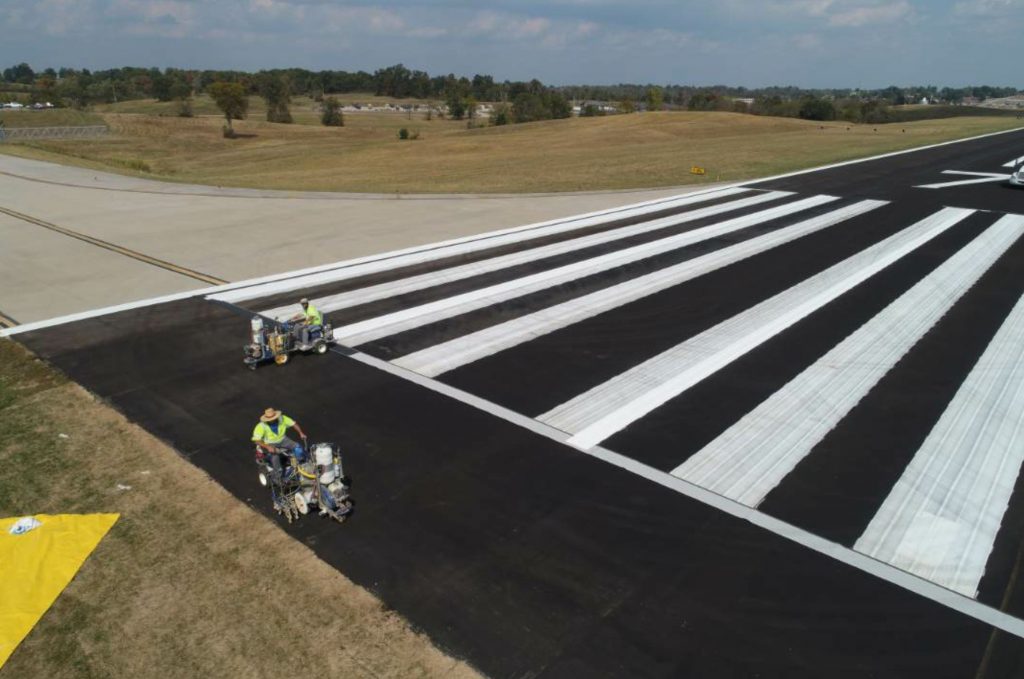Kentucky Takes Micro Surfacing to the Taxiway
BY AsphaltPro Staff

The very first micro surfacing application in Kentucky was performed in 2008, on a four-lane low-volume parkway with an average daily traffic of around 14,000 vehicles, according to the Kentucky Transportation Cabinet (KYTC).
“Everything went really well on that first job,” said Greg Garner, operations and pavement management branch staff engineer at KYTC. Between 2008 and 2012, KYTC continued to put to bid an increasing number of micro surfacing jobs.
Then, in 2012, a micro surfacing job in Pikeville, on U.S. 23, went awry. The micro surface mix cured more slowly than anticipated and the project was hit by unexpected heavy rain shortly after application. “[The mixture] was basically running off the road,” Garner said.
Personnel had to set up car wash stations at the start and endpoint of the job to wash off material that had made its way onto the traveling public’s vehicles. Although they were ultimately able to work alongside the contractor for the job to get a quality final product, it was a situation that propelled KYTC to adjust its approach to micro surfacing.
“Those first four years, we relied heavily on contractors to do a good job—and they did—but we realized we needed to be more involved and that we had a lot to learn,” Garner said. They set forth putting together stronger specs for micro surfacing, attending as much training on the subject as they could, and putting together a training program in the state.
Now, a group of selected individuals from the cabinet meets to update its micro surfacing spec each November. The current spec closely mirrors the spec from the International Slurry Surfacing Association (A143 International Guidelines for Microsurfacing).

American Pavements, Inc., performed the work with a Bergkamp M1E continuous paving machine.
They also host a two-day training event each spring that is open to district personnel, local government officials and contractors covering a variety of pavement preservation topics, with a special focus on either micro surfacing, chip seal and other relatively new treatments to the state each year.
“Micro surfacing and chip seals are hot topics because they’re new here and people are trying to figure out how to do them correctly,” Garner said. More than 80 personnel from KYTC attended the most recent training session on micro surfacing in March 2019, which gave them actionable insight on project selection, calibration, construction and inspection best practices.
The training, during which Garner taught a class on troubleshooting common issues with micro surfacing (check out the sidebar below for more information), went so well that the West Virginia Department of Transportation asked KYTC to put on a similar micro surfacing training in its state.
Since recalibrating its approach to micro surfacing, the state of Kentucky has completed 93 projects totaling 1,000 lane miles. In August 2019, they saw the state’s first micro surfacing application on an airport taxiway/runway.
“We knew some states, like Ohio, were doing a fair bit of micro surfacing at airports,” Garner said, “and we wanted to check it out for ourselves.”
The Airport Approaches
The Capital City Airport is a public airport owned and operated by the Commonwealth of Kentucky, located roughly one mile southeast of the central business district in Frankfort, Kentucky.
Frankfort is Kentucky’s state capital and a principal trading center in the state’s north-central region. The airport, covering 355 acres, has one 5,500-foot runway and is home to nearly 80 aircraft. It sees an estimated 39,200 aircraft operations per year, including state government and Army National Guard operations, corporate activity and hobby flights.
In March, Craig Farmer, the transportation engineering branch manager for the Department of Aviation, reached out to KYTC to see if they had any suggestions for a pavement preservation treatment that could extend the life of the existing pavement within the airport’s limited budget.

The crew performed a double application on the airport’s runway, and a single application.
“The existing surface would probably have lasted another four years before requiring a mill-and-replace,” Garner said. However, KYTC thought micro surfacing could extend the existing pavement’s lifespan eight to 11 years.
“That airport doesn’t get much traffic,” Garner said, adding that most of the pavement deterioration was a result of sun and rain versus traffic. “With micro surface having such a high asphalt content, we thought it could slow down oxidation and limit the amount of water absorbed into the existing pavement.”
The airport brought in American Pavements, Inc., Plain City, Ohio, to perform the work.
American Pavements, Inc. is a pavement preservation company pre-qualified in the states of Ohio, Michigan, Indiana, West Virginia, Pennsylvania, Tennessee and Kentucky. Roughly 80 percent of its business is DOT work, with the other 20 percent coming from local agencies and municipalities. The company has been performing pavement preservation since it was first established nearly three decades ago.
“Micro surfacing, especially on airports, is something we are very familiar with,” said American Pavements Inc. Division Manager Jordan DeLong. “In fact, the Capital City Airport is one of three airports we paved this year with micro surfacing. Wood County Regional Airport, Bowling Green, Ohio, and the Ohio State University Airport, Columbus, were the other two.”
DeLong acquired more than a dozen years’ experience in the asphalt industry before joining American Pavements, Inc. He has been key in expanding the company’s presence into the state of Kentucky. In the 2019 construction season, American Pavements, Inc., successfully performed six micro surfacing projects across the state.

Take Micro Surfacing to Taxiways, Runways
The Capital City Airport job included micro surfacing one taxiway with connectors and the airport’s main runway.
What made the job unique for the crew was that it required a double course on the runway. The taxiway and connectors required a single application, which is more common across the states in which American Pavements, Inc., operates.

Ultimately, the client was pleased with the project’s results. “The double looks really good,” Garner said. “It’ll stay black for a long time and the markings will be move visible.”
According to Garner, since 2008, Kentucky has performed both single and double applications of micro surfacing on all of its roadways. For added durability, beginning 2020, they’ll primarily perform double applications. “Instead of doing 24 pounds per square yard [of strength] with a single lift of Type II, we’ve been doing two lifts for upwards of 36 pounds per square yard with Type III for the base course and Type II for the surface,” Garner said.
For the airport job, the single course was applied at 24 pounds per square foot using a Type II, and the double course was applied in two courses: one of 18 pounds per square yard and one of 14 pounds per square yard, using Type II mix for the first course and Type I for the surface course.
Type I incorporates a finer aggregate and is often accompanied by a higher asphalt cement (AC) content; Type III is the coarsest of micro surfacing aggregate options.

“A lot of micro surfacing specifications have similarities,” DeLong said, “but each state does have their own individual standards to accommodate different weather and traffic volumes. They will modify their specifications for material usage, application rates and standard paving practices to fit their needs. We’re based in Ohio, a state that is highly recognized for its standard practices, specifications, and craftsmanship. Meeting Ohio’s annual criteria for micro surfacing has helped us in creating a reputation as a quality driven contractor.”
A unique aspect of this job was that they originally intended to compact the course using an asphalt roller, an uncommon practice for micro surfaced pavements.
“With highway jobs, the volume of traffic helps get rid of surface irregularities,” DeLong said. “Airports don’t get the average daily traffic per year of your normal highways. Rollers are sometimes specified in this manner when there is an absence of vehicles.”

The single course was applied at 24 pounds per square foot using a Type II mix, and the double course was applied in two courses: one of 18 pounds per square yard and one of 14 pounds per square yard, using Type II mix for the first course and Type I for the surface course.
However, when American Pavements, Inc., compacted a 100-foot trial section, the consulting firm over the project was dissatisfied with the results they were getting and ceased rolling operations until the final days of the project when the micro surface had cured.
The 21 days given to complete the project was a tight timeline and created additional scheduling challenges well beyond a standard contract. The 21 days were broken into three phases: phase one to crack seal; phase two to do pavement repair, shouldering, topsoil, micro surfacing and temporary striping; and phase three for punch list items and permanent striping. Three stop/go’s were issued over the course of two months to schedule all work items.
Ultimately, the client was pleased with the project’s results. “The double looks really good,” Garner said. “It’ll stay black for a long time and the markings will be move visible.”
Kentucky Plans for the Future
Kentucky has experienced a paving deficit for all of Garner’s 10 years at KYTC. In 2019, the paving deficit, excluding interstate, parkway and rural secondary routes, is $600 million.
“When using low cost applications such as micro surface, we are able to treat more lane miles using less dollars,” Garner said. “This enables you to treat more miles than what deteriorates to poor condition, thus improving the asset sustainability ratio.”
Two years ago, Garner said, he had 330 centerline miles to pave in an eastern Kentucky district. Now, they’ve reduced that to 175 centerline miles.
“People often ask us why we’re fixing roads that don’t look like they need to be fixed,” Garner said. “They see a crew out working on a street that was paved only six years ago and think, ‘Why aren’t they out fixing KY 285?’ or other roads in rougher shape. I frame it in a way everyone can relate to: you wouldn’t wait for the engine to fall out of your car before you work on it, change the oil, and do regular maintenance. It’s the same with our roads.”
He adds micro surfacing projects are trending in the right direction to meet needs based on available preservation funds.
“We’re spending roughly 20 percent of our overall preservation budget on micro surfacing, thinlays, cape seals, chip seals, etc., and I think that’s a good number for us,” Garner said. “If the overall preservation budget grows, then we’ll do more micro surfacing than we are right now. But, I think the proportions are right for us right now.”
Airports like Capital City could be a new frontier. “We’re expanding what we’ve learned performing micro surfacing on roadways to runways,” said Executive Director of the Office of Public Affairs Naitore Djigbenou. “We have 52 general aviation airports in Kentucky, so there is a lot of potential for future projects following this first one.”
When all was said and done, the micro surfacing job at Capital City Airport both allowed Kentucky to test out micro surfacing for airport applications alongside an experienced contractor and offered one more opportunity for DeLong and American Pavements, Inc., to prove their skills in a new market.
“We have a good reputation in the states where we had an existing presence, and I think after the 2019 season, we also have a good reputation for the work we’ve done in Kentucky,” DeLong said. “They’ll continue to have bids out and we’ll continue to take swings at them and hope to work with them in the future.”
